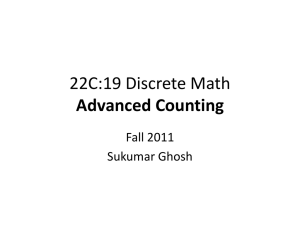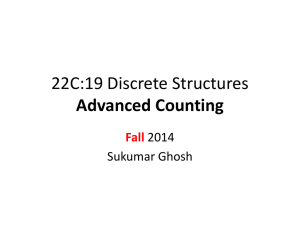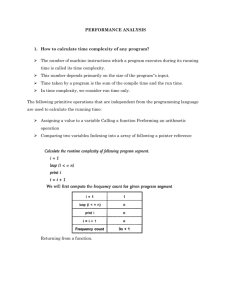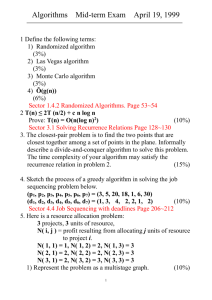Problem_Set_04 - ArsDigita University
advertisement
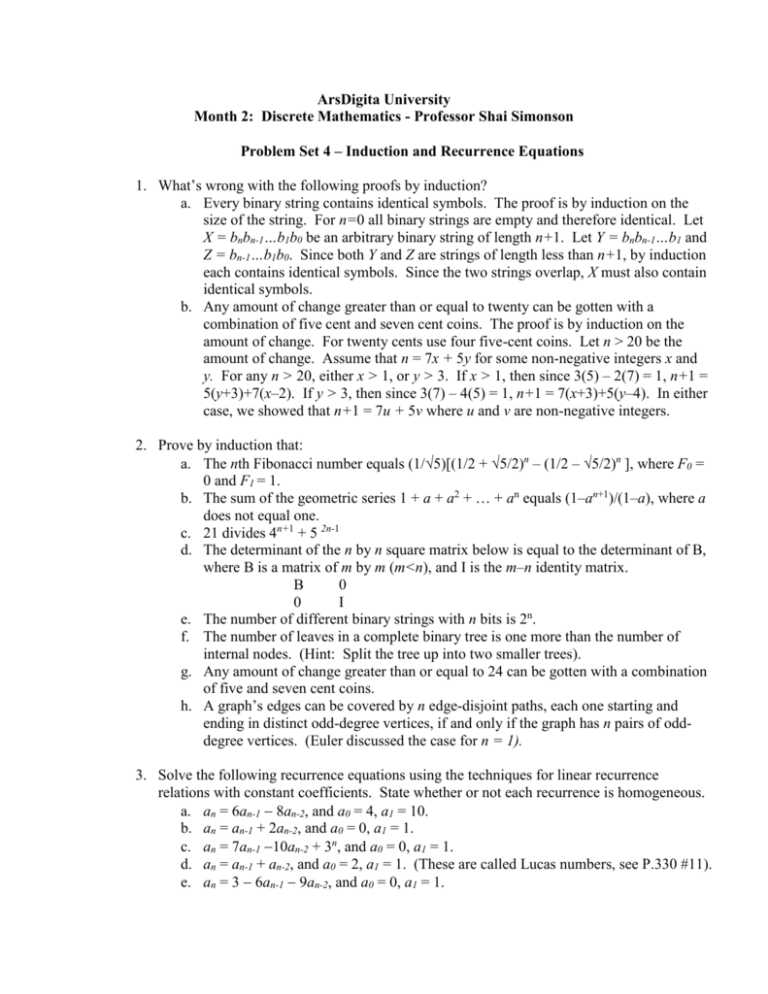
ArsDigita University Month 2: Discrete Mathematics - Professor Shai Simonson Problem Set 4 – Induction and Recurrence Equations 1. What’s wrong with the following proofs by induction? a. Every binary string contains identical symbols. The proof is by induction on the size of the string. For n=0 all binary strings are empty and therefore identical. Let X = bnbn-1…b1b0 be an arbitrary binary string of length n+1. Let Y = bnbn-1…b1 and Z = bn-1…b1b0. Since both Y and Z are strings of length less than n+1, by induction each contains identical symbols. Since the two strings overlap, X must also contain identical symbols. b. Any amount of change greater than or equal to twenty can be gotten with a combination of five cent and seven cent coins. The proof is by induction on the amount of change. For twenty cents use four five-cent coins. Let n > 20 be the amount of change. Assume that n = 7x + 5y for some non-negative integers x and y. For any n > 20, either x > 1, or y > 3. If x > 1, then since 3(5) – 2(7) = 1, n+1 = 5(y+3)+7(x–2). If y > 3, then since 3(7) – 4(5) = 1, n+1 = 7(x+3)+5(y–4). In either case, we showed that n+1 = 7u + 5v where u and v are non-negative integers. 2. Prove by induction that: a. The nth Fibonacci number equals (1/5)[(1/2 + 5/2)n – (1/2 – 5/2)n ], where F0 = 0 and F1 = 1. b. The sum of the geometric series 1 + a + a2 + … + an equals (1–an+1)/(1–a), where a does not equal one. c. 21 divides 4n+1 + 5 2n-1 d. The determinant of the n by n square matrix below is equal to the determinant of B, where B is a matrix of m by m (m<n), and I is the m–n identity matrix. B 0 0 I e. The number of different binary strings with n bits is 2n. f. The number of leaves in a complete binary tree is one more than the number of internal nodes. (Hint: Split the tree up into two smaller trees). g. Any amount of change greater than or equal to 24 can be gotten with a combination of five and seven cent coins. h. A graph’s edges can be covered by n edge-disjoint paths, each one starting and ending in distinct odd-degree vertices, if and only if the graph has n pairs of odddegree vertices. (Euler discussed the case for n = 1). 3. Solve the following recurrence equations using the techniques for linear recurrence relations with constant coefficients. State whether or not each recurrence is homogeneous. a. an = 6an-1 8an-2, and a0 = 4, a1 = 10. b. an = an-1 + 2an-2, and a0 = 0, a1 = 1. c. an = 7an-1 10an-2 + 3n, and a0 = 0, a1 = 1. d. an = an-1 + an-2, and a0 = 2, a1 = 1. (These are called Lucas numbers, see P.330 #11). e. an = 3 6an-1 9an-2, and a0 = 0, a1 = 1. 4. A particular graph-matching algorithm on n nodes, works by doing n2 steps, and then solving a new matching problem on a graph with one vertex less. a. Show that the number of steps it takes to run the algorithm on a graph with n nodes is equal to the sum of the first n perfect squares. b. Derive the formula for the sum of the first n perfect squares by constructing an appropriate linear non-homogeneous recurrence equation and solving it. c. Show that the time complexity of this algorithm is (n3). 5. Write a recurrence relation to compute the number of binary strings with n digits that do not have two consecutive 1’s. Solve the recurrence, and determine what percentage of 8-bit binary strings do not contain two consecutive 1’s. 6. Strassen’s algorithm shows how to multiply two n by n matrices by multiplying 7 pairs of n/2 by n/2 matrices, and then doing n2 operations to combine them. Write the recurrence equation for this algorithm, and calculate the complexity of Strassen’s algorithm, by solving the recurrence by repeated substitution. 7. Write and solve the recurrence equations for the time complexity of the following recursive algorithms. Explain why your equations are correct. a. To search for a value in a sorted list, compare it to the middle value, and search the right half of the list if it is larger, and the left half if it is smaller. b. The maximum of a list of numbers is the larger of the maximum of the first half and the maximum of the second half. c. To sort a list of numbers, divide the list into four equal parts. Sort each part. Merge these sorted four lists into two sorted lists, and then merge the two into one. 8. Solving recurrences by a change of variable. a. Given an = 2an-1 + an-2 and a0 = 0, a1 = 1, note that: an = (1 + 2)an-1 + (1 2)[an-1 (1+2)an-2] = (1 2)an-1 + (1 + 2)[an-1 (12)an-2] Let bn = an – (1 + 2)an-1 = (1 2)[an-1 (1+2)an-2], and cn = an – (1 2)an-1 = (1 + 2)[an-1 (12)an-2] . Construct two simple recurrence equations for bn and cn and solve each one. Then note a connection between an, bn and cn, and solve the original equation. b. Use this technique to compute a closed form for the nth Fibonacci number. c. an = 2an + lg n, a2 = 1 (Solve by setting m = lg n). You may assume that n is 2 to the power of 2k. 9. Parenthesized Expressions a. A sequence of n+1 matrices A1A2…An+1 can be multiplied together in many different ways dependent on the way n pairs of parentheses are inserted. For example for n+1 = 3, there are two ways to insert the parentheses: ((A1A2)A3) and (A1(A2A3)). Write a recurrence equation for the number of ways to insert k pairs of parenthesis. Do not solve it. (Hint: Concentrate on where the last multiplication occurs). b. Write a list of the different ways to parenthesize a sequence of n+1 matrices for n+1=2,3,4. c. A balanced arrangement of parenthesis is defined inductively as follows: The empty string is a balanced arrangement of parentheses. If x is balanced arrangement of parentheses then so is (x). If u and v are each a balanced arrangement of parentheses, then so is uv. Write a list of strings that represent a balanced arrangement of n pairs of parentheses for n=1,2,3. d. Describe a 1-1 correspondence between the strings that are balanced arrangements of n pairs of parentheses, and the number of ways to multiply a sequence of n+1 matrices. 10. Solve the following recurrence equation using linear algebra techniques of diagonalization. an = 2an-1 + an-2, where a0 = 0 and a1 = 1. 11. Prove that any O(|E|) time algorithm on a planar simple graph is also O(|V|). (Hint: Use the fact that every face has at least three vertices and edges, and a counting argument, to calculate a relationship between the number of faces and the number of edges. Then use Euler’s Theorem to derive a linear relationship between the number of edges and the number of vertices.) 12. The following recurrence cannot be solved using the master theorem. Explain why. Solve it directly by substitution, and calculate its order of growth. T(n) = 4T(n/2) + (nlogn)2 and T(1) = 1.


